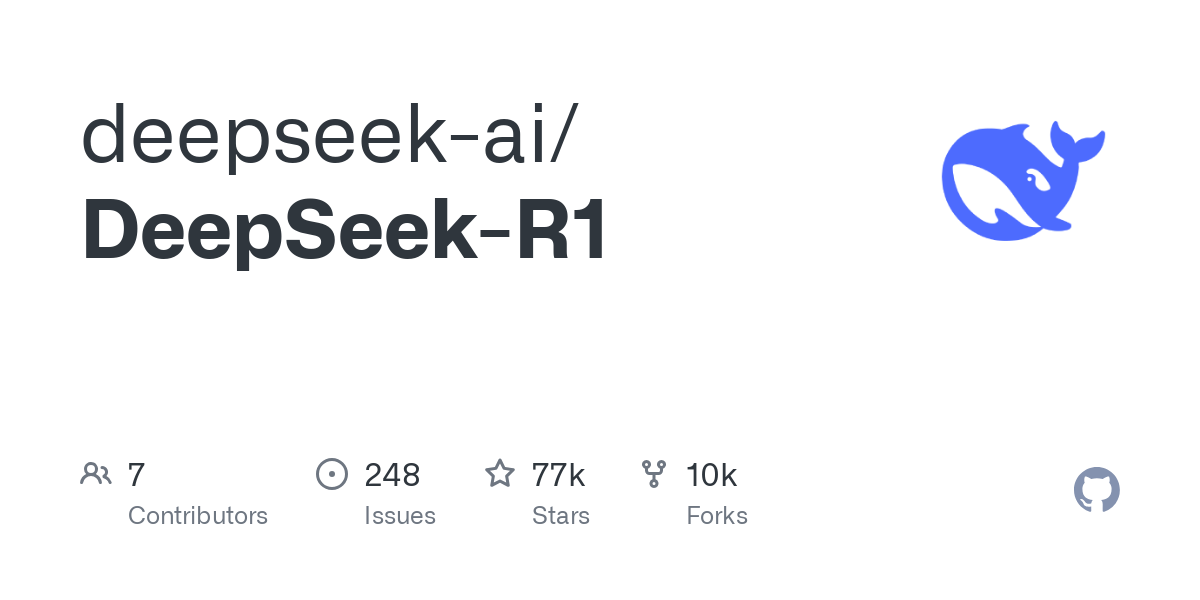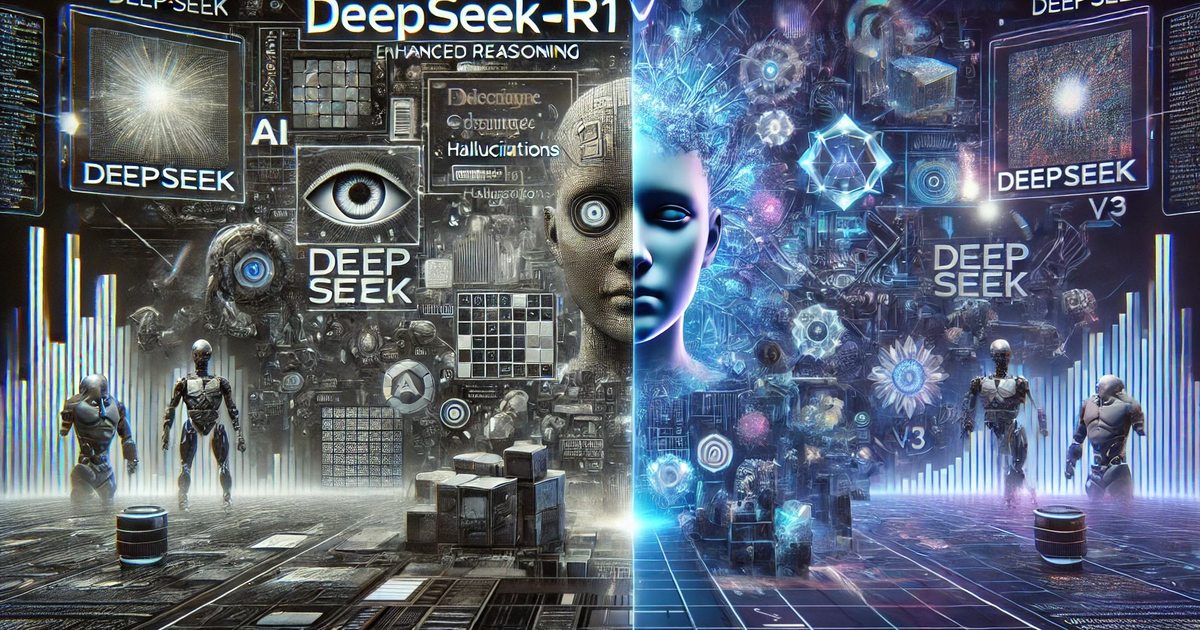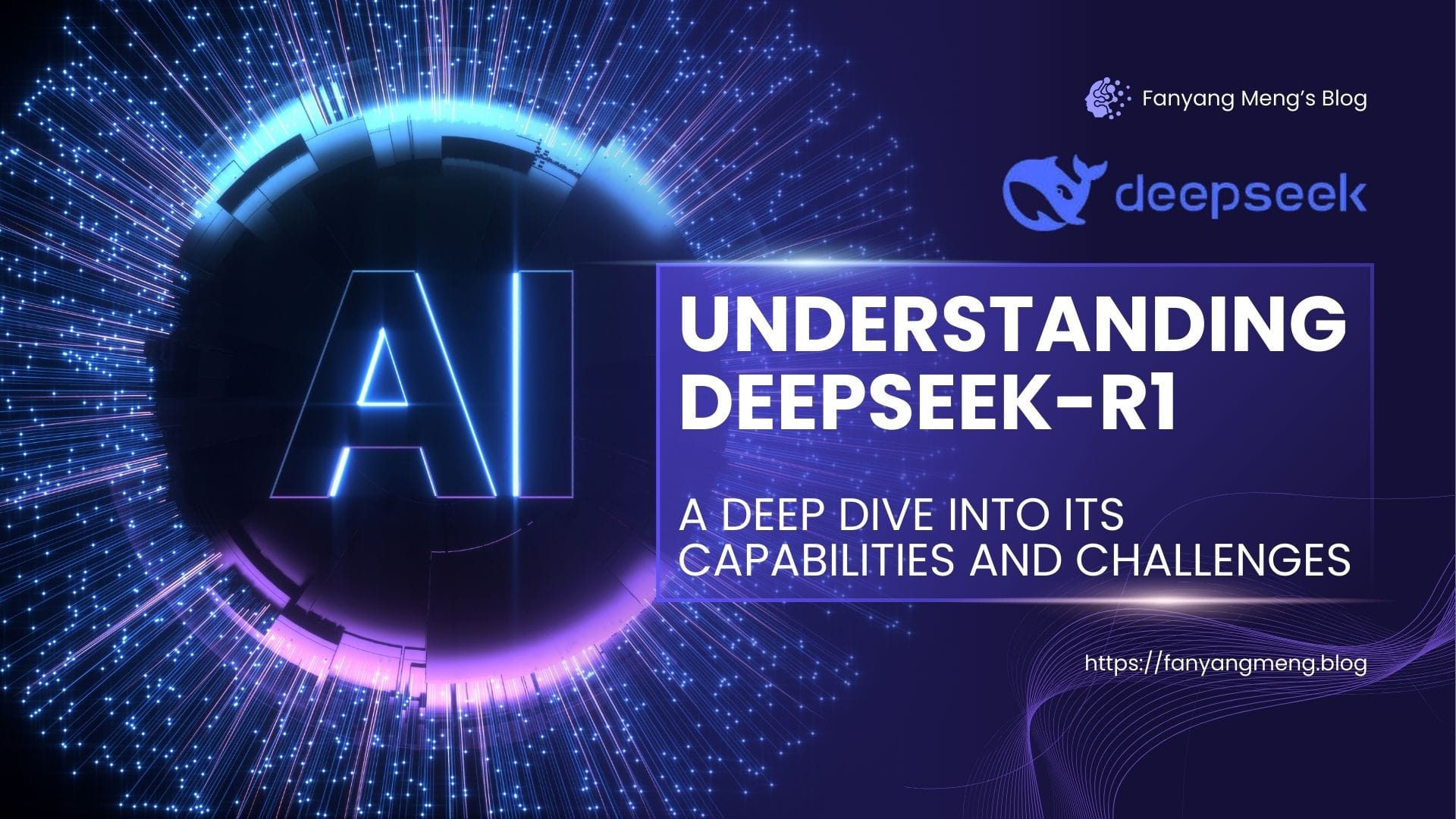Introduction

In January 2025, DeepSeek-AI unveiled DeepSeek-R1, marking a significant advancement in language model reasoning capabilities. This model represents a novel approach to enhancing artificial intelligence reasoning through reinforcement learning (RL), achieving performance levels comparable to OpenAI's O1 model but at approximately 25x lower operational costs. The development of DeepSeek-R1 was achieved with a reported investment of just $5.5 million, though this figure has been subject to debate within the AI community.
The research introduces two key variants: DeepSeek-R1-Zero, which employs reinforcement learning without any initial supervised examples, and DeepSeek-R1, which utilizes a small set of high-quality, curated examples as a starting point. This approach demonstrates how models can develop sophisticated reasoning abilities through self-evolution, while also revealing important trade-offs between enhanced reasoning capabilities and factual consistency.
Understanding the Challenge of Machine Reasoning
Traditional language models excel at pattern recognition but struggle with complex logical reasoning tasks requiring multi-step problem solving. While techniques like chain-of-thought (CoT) prompting helped models "show their work," significant gaps remained in mathematical reasoning, coding challenges, and scientific problem-solving.
The DeepSeek team identified three core limitations in existing approaches:
- Over-reliance on supervised fine-tuning (SFT) requiring massive labeled datasets;
- Inefficient exploration of solution spaces during training;
- Difficulty transferring reasoning skills to smaller, more practical models.
Their solution? A radical reimagining of reinforcement learning (RL) pipelines that enables models to self-improve through trial and error, much like humans learning through experience.
Understanding the Reinforcement Learning Revolution
Reinforcement learning operates on the principle of trial-and-error learning, where an AI agent improves its performance through continuous interaction with its environment. In the context of language models, this translates to systematically refining the model's reasoning processes through reward-based feedback mechanisms.
Traditional approaches relied heavily on supervised fine-tuning (SFT), where models learn from human-curated examples. The DeepSeek team challenged this paradigm by developing DeepSeek-R1-Zero, a model that skips SFT entirely and develops reasoning capabilities through pure RL. This approach mirrors how humans develop problem-solving skills through practice and feedback rather than direct instruction.
The DeepSeek-R1 Architecture: A Two-Pronged Approach
DeepSeek-R1-Zero: Pure Reinforcement Learning
Reinforcement learning (RL) has traditionally been combined with supervised learning in language model development. DeepSeek's R1-Zero represents a significant departure from this convention by relying exclusively on RL for training. This breakthrough demonstrates that models can develop sophisticated reasoning capabilities through pure trial-and-error learning, without requiring human-labeled training data.
Using an innovative approach called Group Relative Policy Optimization (GRPO), the model developed three crucial cognitive capabilities:
- Self-verification became an emergent behavior, where the model learned to automatically validate its intermediate steps during problem-solving. This mimics how human experts often check their work at critical junctures rather than waiting until the end.
- The model developed reflective reasoning abilities, enabling it to recognize when its initial approach wasn't optimal and dynamically adjust its strategy. This meta-cognitive skill is particularly valuable for complex mathematical and logical problems.
- Through extensive exploration, the model learned to generate and evaluate multiple solution paths before committing to one. This approach helps avoid local optima and finds more elegant solutions.
The model's performance on the American Invitational Mathematics Examination (AIME) 2024 validated this approach, achieving an 86.7% pass rate using majority voting—matching the capabilities of OpenAI's o1-0912 model. However, while mathematically competent, the pure RL approach revealed limitations in producing consistently readable and natural language outputs.
DeepSeek-R1: Hybrid Training for Enhanced Performance
To address these limitations while preserving R1-Zero's strong reasoning capabilities, DeepSeek developed R1 using a sophisticated multi-stage training pipeline:
1. The cold-start initialization phase:
Before RL begins, models undergo supervised fine-tuning using:
- 1,000+ manually curated reasoning examples
- 500+ general capability prompts (writing, QA, etc.)
- Structured templates enforcing CoT formatting
This phase establishes basic reasoning patterns and output conventions, addressing R1-Zero's readability issues
2. The reasoning-focused RL phase, The core RL process iterates through:
- Prompt sampling: Selecting diverse problems from math/coding benchmarks
- Solution generation: Producing 4-8 candidate solutions per problem
- Reward calculation: Scoring based on accuracy and formatting
- Policy update: Adjusting model weights via GRPO's advantage-weighted loss.
3. Alignment RL represents a broader optimization phase that balances multiple objectives: maintaining high performance on technical tasks while improving output readability, ensuring factual accuracy, and incorporating safety considerations.
This ensures the model remains helpful and harmless across all applications
This hybrid approach proved highly effective. Importantly, these improvements in technical reasoning came without sacrificing the model's ability to engage in natural conversation, demonstrating that hybrid architectures can successfully balance specialized capabilities with general-purpose functionality.
The progression from R1-Zero to R1 illustrates a key principle in AI development: while pure approaches can achieve breakthrough results, thoughtfully combining multiple training methodologies often leads to more well-rounded and practical systems.
The Science Behind the Training
GPRO (Group Relative Policy Optimization)
Imagine you're coaching a basketball team. In traditional reinforcement learning, it's like training each player individually by just looking at how many points they score. This works, but it misses something important - basketball is a team sport!
GRPO (Group Relative Policy Optimization) is like a smarter coaching method that looks at how players work together as a team. Instead of just saying "Player A scored 20 points, good job!", it considers things like "Player A scored 20 points because Player B kept setting up great passes." It understands that success comes from good teamwork, not just individual performance.
The "relative" part in GRPO means it judges performance in context. Going back to basketball, scoring 10 points as a center might be average, but scoring 10 points as a defensive specialist would be exceptional. GRPO takes this into account by comparing players within their roles or "groups."
Another key idea is stability. Just like you wouldn't completely change a player's shooting technique if they're having one bad game, GRPO makes small, careful adjustments to how agents (like players) behave. It tries to improve things gradually while keeping what's already working well.
The "group" aspect is particularly important because it helps solve one of the hardest problems in multi-agent learning: figuring out who deserves credit for success. If your team wins, was it because of the amazing shooter, the great defensive plays, or the clever passing? GRPO helps figure this out by looking at how different groups of agents contribute to the overall success.
Think of it as a coaching system that's good at both developing individual skills and building team chemistry. It knows when to push for individual improvement and when to focus on better cooperation.
Reward Engineering
Think about learning to make a traditional pasta dish from scratch. The reward system described has three main parts:
- Accuracy rewards (Did you make good pasta?) This is like the final taste test - either the pasta is good or it's not. It's a simple yes/no reward, just like getting the final answer right or wrong in problem-solving. There's no middle ground here - it either works or it doesn't.
- Format rewards (Did you follow the recipe structure?) This is like checking if you organized your ingredients properly, kept your workspace clean, and followed the basic steps in order. Even if the final pasta isn't perfect, following good cooking practices is important and gets rewarded. In problem-solving, this means showing your work in a clear, structured way.
- Process rewards (Did you execute each step correctly?) This is like checking if you kneaded the dough for the right amount of time, got the sauce consistency right, and cooked the pasta to the proper doneness. These are rewards for getting the intermediate steps right, not just the final result.
The interesting part about avoiding neural reward models is particularly clever. It's like saying "we won't use a computer to taste-test the food" because the computer might start favoring easy-to-measure things (like the color of the pasta) rather than what makes the pasta actually good (its taste and texture). Instead, they use clear, direct measurements that can't be "gamed" or tricked.
Performance Analysis
Benchmark Results
DeepSeek-R1 demonstrates impressive performance across various benchmarks:
- Mathematics: Achieves 79.8% pass@1 on AIME 2024 and 97.3% on MATH-500
- Coding: Attains a 96.3 percentile rating on Codeforces
- Knowledge: Scores 90.8% on MMLU and 71.5% on GPQA Diamond
- General Tasks: Exhibits strong performance in creative writing and question-answering, with an 87.6% win-rate on AlpacaEval 2.0
The Distillation Breakthrough
Perhaps the most impactful innovation lies in knowledge distillation—transferring R1's reasoning capabilities to smaller models. The team demonstrated that:
- 14B distilled models outperform 32B baseline models
- Qwen2.5-32B distilled version achieves 72.6% on AIME 2024
- Even 1.5B models show significant reasoning improvements
This breakthrough suggests that:
- Reasoning patterns can be separated from model scale
- Specialized training matters more than parameter count
- Efficient deployment of reasoning AI becomes practical
The open-sourced distilled models (1.5B to 70B parameters) set new standards for accessible high-performance AI.
Understanding the Hallucination Mechanism
As artificial intelligence continues to evolve, I am discovering fascinating quirks in the DeekSeek R1, presents an intriguing case study in how sophisticated reasoning capabilities can sometimes lead to unexpected consequences.
I first noticed this phenomenon while planning a trip to Florida. When I asked DeekSeek R1 to create an itinerary for Miami Beach, it confidently recommended visiting "The Coral Cove Café near South Pointe Park," describing it as a historic establishment known for pioneering Cuban fusion cuisine in the 1960s. While Miami Beach certainly has its share of Cuban restaurants, this particular café was entirely fabricated—a small but telling example of the model's tendency to invent details.
This wasn't an isolated incident. DeepSeek-R1's tendency to hallucinate presents an intriguing case study in the relationship between reasoning capabilities and factual accuracy. According to Vectara's analysis, the model exhibits a significantly higher hallucination rate of 14.3% compared to DeepSeek-V3's 3.9%. This phenomenon can be better understood by examining how R1's training shapes its behavior.

Think of R1 as a brilliant academic prodigy with a focus on mathematics and logic. Through extensive reinforcement learning, it has developed exceptional capabilities in fields requiring rigorous reasoning. When asked about Florida's water management systems, it can provide detailed, accurate calculations about water flow and environmental impact. However, when tasked with describing historical events or open-ended questions about Florida culture, it sometimes strays into fiction.
The root of this behavior lies in R1's training history. During its initial phase as R1 Zero, the model received rewards through two channels: direct verification of correctness for mathematical and programming problems, and adherence to specified formats. The final reinforcement learning stage employed a dual-track system, where math and programming solutions were system-verified, while open-ended tasks were evaluated by humans.
This training methodology has created an AI that prioritizes logical consistency over factual accuracy. When faced with incomplete information, rather than acknowledging uncertainty, R1 fills in gaps with plausible assumptions. For instance, when asked about the development of Orlando's theme parks, it created a detailed but partially fictional account of Walt Disney's first visit to Central Florida, including fabricated conversations with local officials and specific details about meetings that were never documented.
I once experienced this firsthand when asking R1 about Florida's mysterious Coral Castle. When challenged about some of its claims regarding the construction methods, the model spiraled into an elaborate narrative about secret technological advances in 1920s Florida, even suggesting that the builder had discovered a lost Seminole method of limestone manipulation.
Interestingly, this challenge isn't unique to DeekSeek R1. Other reasoning models, such as Google's Gemini 2.0 Flash Thinking, exhibit similar tendencies. These models can produce lengthy analyses about historical events—like the specific mood in St. Augustine during Henry Flagler's first railway arrival—while maintaining perfect logical coherence, despite the obvious impossibility of knowing such intimate details.
Perhaps most fascinating is the correlation between writing quality and hallucination frequency. DeekSeek R1's writing surpasses that of Gemini 2.0 Flash Thinking, yet it also demonstrates a higher propensity for hallucination. When describing the Florida Everglades, it crafts beautifully detailed narratives about ecosystem interactions, but sometimes includes species or behaviors that don't actually exist in the region.
As we continue to develop and refine AI models, finding the right balance between logical reasoning capabilities and factual accuracy remains a crucial challenge. The case of DeekSeek R1 serves as a reminder that even the most sophisticated AI systems can sometimes prioritize logical completeness over factual truth—a tendency that both showcases their remarkable capabilities and highlights their current limitations.
Technical Innovations and Limitations
Key Technical Achievements
- Implementation of Group Relative Policy Optimization (GRPO) for efficient reinforcement learning
- Development of a novel reward system combining accuracy and format adherence
- Successful distillation of reasoning capabilities to smaller models
Current Limitations
- Increased hallucination rates compared to previous models
- Challenges with language mixing in multilingual contexts
- Sensitivity to prompt engineering
- Limited performance in software engineering tasks due to evaluation time constraints
Future Directions and Challenges
The development of DeepSeek-R1 presents both promising opportunities and significant challenges that need to be addressed:
Balancing Reasoning and Reality
The primary challenge lies in maintaining the model's impressive reasoning capabilities while improving its factual accuracy. This requires developing new training methodologies that can:
- Teach models to acknowledge uncertainty appropriately
- Maintain logical rigor without forcing connections where data is incomplete
- Develop better mechanisms for fact verification in open-ended scenarios
Training Methodology Evolution
Future iterations of reasoning models like DeepSeek-R1 might benefit from:
- Hybrid reward systems that balance logical consistency with factual accuracy
- Better integration of uncertainty handling in the reinforcement learning process
- More sophisticated verification mechanisms for open-ended tasks
- Improved methods for distinguishing between scenarios requiring logical deduction versus factual recall
Conclusion
DeepSeek-R1 represents a significant advancement in AI reasoning capabilities through reinforcement learning. While achieving impressive performance across various benchmarks, it also highlights important challenges in balancing enhanced reasoning abilities with factual accuracy. The success of its training methodology, particularly the effectiveness of pure reinforcement learning in developing reasoning capabilities, provides valuable insights for future AI development.
The increased hallucination rates observed in DeepSeek-R1 serve as an important reminder of the complexities involved in advancing AI capabilities. As the field progresses, finding ways to maintain factual consistency while pushing the boundaries of reasoning abilities remains a crucial challenge.
The open-source nature of DeepSeek-R1 and its successful distillation to smaller models suggest a promising future for more accessible and efficient AI systems. However, careful consideration must be given to the trade-offs involved in pursuing enhanced reasoning capabilities, particularly in applications where factual accuracy is paramount.



Discussion